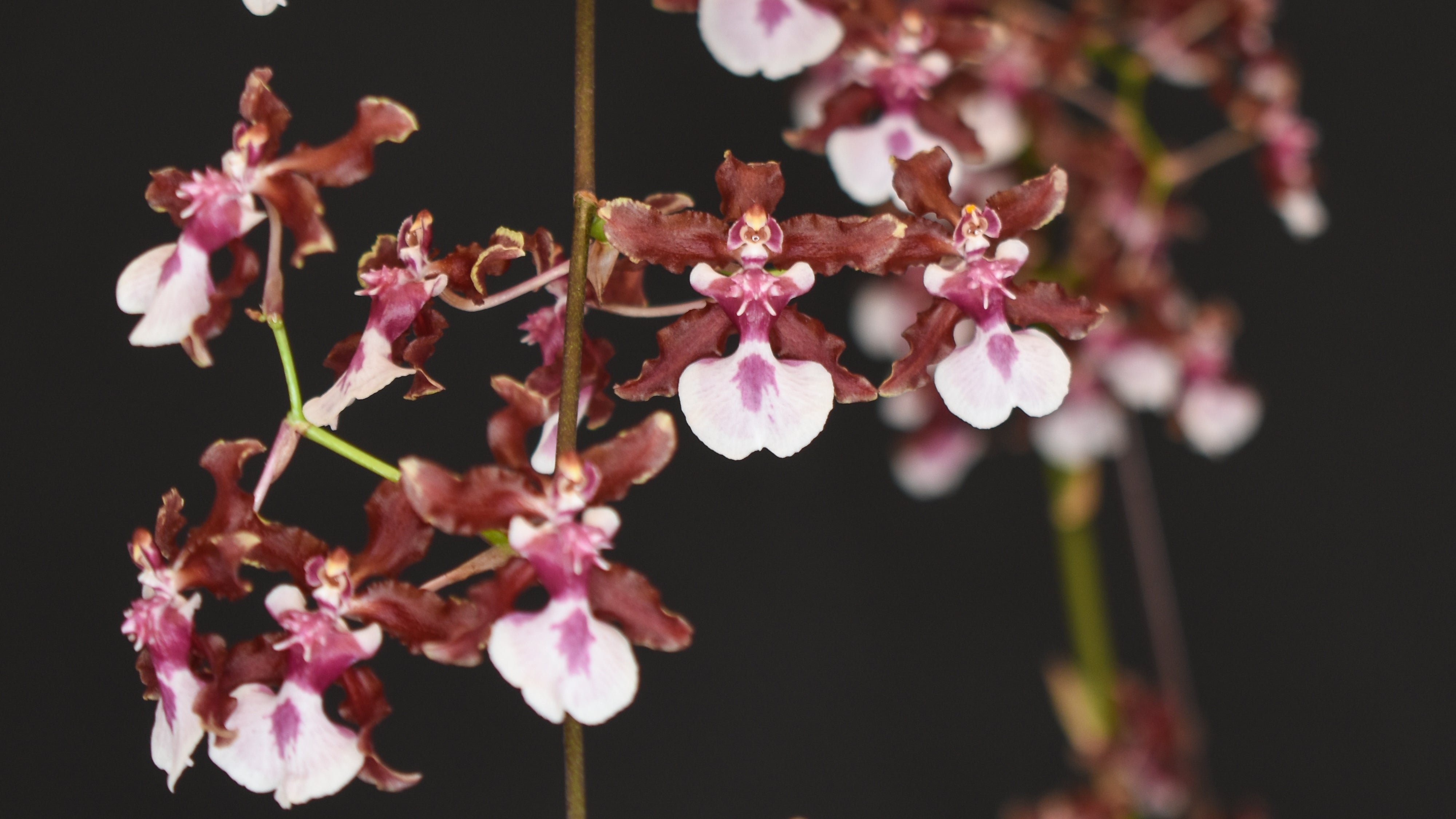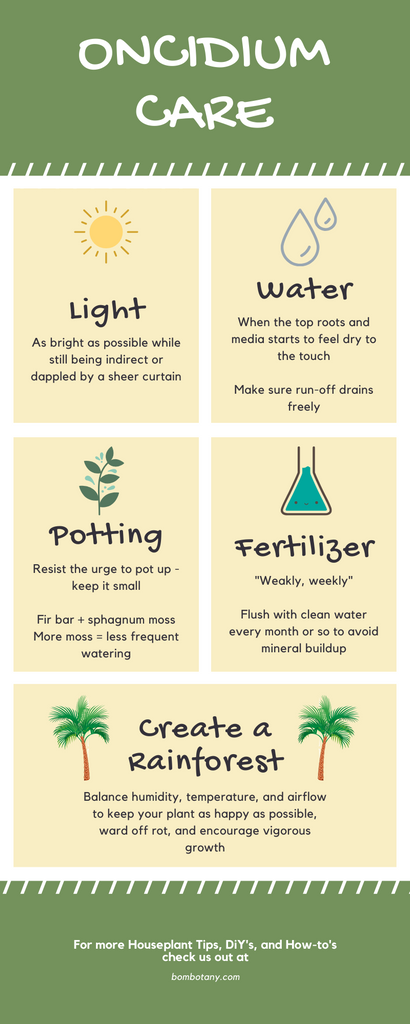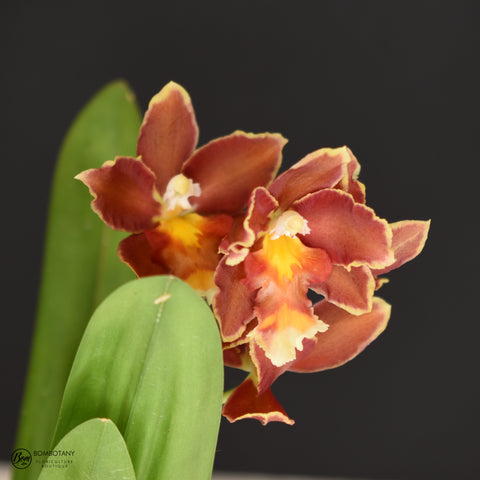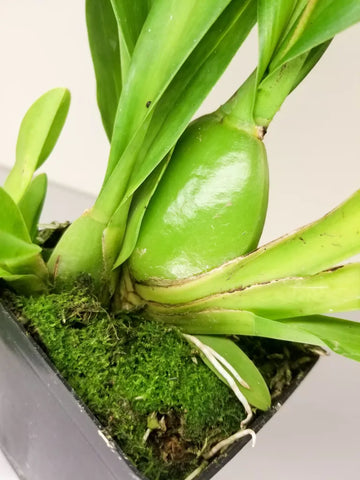
Oncidium Orchid Complete Care Guide

The Oncidium orchid genus, often abbreviated to just Onc, belongs to the angiosperm family Orchidaceae. Around 300 gorgeous species fall under this plentiful genus. Common names for these orchids include Dancing Lady or Golden Shower orchid, aptly named for their yellow-brown to golden dress-like petal arrangements. Some species change it up and exhibit white, red, pink, purple, and orange hues. No matter which way you spin it, they’re beautiful!
Oncidium orchids were originally described by the late Swedish botanist and taxonomist Olof Swartz. He used the Greek word “onkos”, for the beginning of the genus name Oncidium. Onkos means “swelling”, which describes the flower petals’ uniquely bumpy lip. Oncidium species usually flower in an array of inflorescence, stemming from racemes attached to mature stems. These medium sized orchids have leaves which can grow up to two feet lengthwise. Some varieties can reach a height of ten feet, although most hybrids are around one to two feet.
Oncidium orchids possess large pseudobulbs, a storage organ found on many orchids that support the stem, leaves, and flowers while also acting as a battery of nutrients and hydration. Pseudobulb clusters are nestled upon a mass of thin white fibrous roots that attach and support the plant within a substrate. Like other orchid species, Oncidiums are very versatile and able to grow in a range of mediums. Most orchids are epiphytic (plants that grow on the surface of other plants) or lithophytic (plants that grow on the surface of rocks). Orchids, Oncidium included, adapt exceptionally well to pots if planted with appropriate potting media.
Oncidiums grow well in normal indoor conditions, making them very popular amongst indoor hobbyists and commercial florists alike. The Oncidium genus has been greatly hybridized, resulting in numerous beautiful varieties that are all too easy to adore. We sell flowering Oncidium orchids too!
Oncidiums are generally easy to grow and care for, however there are a few essentials you’ll want to tuck into your mental toolbelt to make sure you’re getting the best out of your beautiful little babies.
Light
Oncidiums are native to lush Central and South American jungles, so they prefer bright but indirect or diffused light. Placing them near a southern window, or in an east or west window is generally ideal for your little guys. It’s important to note that most orchids come from areas with consistent 12-hour day-lengths. If you’re in the northern hemisphere, and it’s winter, windows facing due west or east offer a woefully narrow day-length (your house is in the way for half the day). Morning sun from the east is gentler than midday and afternoon rays, so don’t be afraid to go with direct eastern exposures. Even if the days are shorter, east/west exposures offer the kind of light intensity your plant craves. If your place has limited lighting options, you can always opt for a window that’s too bright, and filter the light down using drapes, blinds, or even other plants. If your place is particularly dark, check out LED grow lights. These can be found relatively cheap and will allow you to fine-tune the amount and duration of light that your babies will receive, keeping them as nice and happy as can be!
Oncidium Cat Love
Water
Orchids don’t particularly like lots of water, being epiphytes and all. They’ve adapted to receive small amounts of water at frequent intervals. If you approach orchid care like you would regular houseplant care (keeping things moist around the clock), you’re asking for root rot! A good approach is to water Oncidium orchids just as the substrate they’re planted in nears dryness. This will be around every 5-7 days depending on environmental factors like potting media, humidity, day-length, temperature, etc. If you live in a hardiness zone with distinct summers and winters, water more frequently during the warmer months and less frequently during the cooler months of winter. Oncidium orchids are used to dryer winters. If you keep an indoor orchid, there won’t be significant temperature changes throughout the year, however humidity drops off during the winter, even indoors. While many Oncidium varieties don’t have a strict ‘winter dormancy’ period, they will appreciate less fertilizer and less frequent watering. On that note, consider investing in a hygrometer, they’re available for cheap around the web.
Don’t stress if you miss watering your orchid on occasion, Oncidiums are quite drought tolerant. Their pseudobulbs act as little water tanks, storing moisture for dry periods. Pseudobulbs are also a great indicator of chronic under-watering. The bulb will shrink and shrivel if you’ve been neglecting them – it will usually take a few weeks of proper hydration to bounce back. Pseudobulb shrivel is a long-term issue – you won’t solve it by watering your plant too frequently. Your living, breathing orchid wants air just as much as it wants water.

Perfectly hydrated, as all thing should be
The best way to tell if your orchids need a drink is to stick your finger or the head of a wooden pencil into the substrate. If you feel moisture, or the end of the pencil turns a darker color, you will know the mix is still wet enough and you can afford to wait another day or two before watering again.
Oncidiums prefer clean, preferably filtered water without a large amount of mineral content. Fill a spray bottle with water, this way there’s time for unwanted chemicals to evaporate. There’s no such thing as overwatering an orchid in one go, so long as you don’t let your plant stand in water. Water at too frequent of intervals is the true enemy. If you trust your tap water, the hose attachment on your kitchen sink makes things all the easier. A spray bottle will help you avoid spillage if you’d rather leave your plant pal in place on the windowsill. Be sure to give a quick squirt on their foliage and stems, this keeps the humidity at levels they enjoy. As a thin leaved species that retains less moisture than Phalaenopsis or Dendrobium, Oncidium orchids particularly like this.
DONT 👏 WATER 👏 USING 👏 ICE 👏 CUBES 👏
Orchids are live tropical plants! How would you feel if you were only allowed to eat ice chips for the rest of your life? HMM???
Potting & Soil
Oncidiums enjoy being under-potted or nearly rootbound. Throw everything you know about terrestrial plants out the window (don’t throw the actual plants though)! Think about it – orchids grow on the sides of trees and use hardy roots to dig into bark and latch on TIGHT. It’s the word of the day – they’re epiphytes! They do well in medium sized fir bark chips (1/8 to 1/4 inch), which allow for a good amount of air exchange, water retention, and room for roots to expand. Fir bark degrades after about 3 years, at which point the chips begin to break down, become easily water-logged, and release fatal levels of nutrients.
|
If you find yourself watering too frequently, or humidity levels too low, consider mixing in sphagnum or peat moss as you see fit. |
Orchids are fairly resilient, but if you want them to stay optimally healthy and keep up their rapid growth spurts, it’s a good idea to repot every 1 to 2 years. Water your plant first! Dry roots crack very easily. Carefully remove the pot from the base of the plant and clean the roots of any old mix, being very careful not to break any. Take a good look at the roots at this point, and snip away any brown, papery, or mushy roots. Healthy roots will be silver-white, firm, and have a green tint when wet. Actively growing roots have bright green tips. Healthy roots are crucial for an orchid’s quick adjustment to a new pot. Always work with clean pruning snips/scissors. Wash them first in warm, soapy water to remove any possible bacteria, and avoid transferring infections (gross!) from plant to plant.
Fertilizer
Be careful when fertilizing orchids. It’s easy to burn their sensitive roots if you get a bit too overzealous about your fertilizer-to-water ratios.
Popular potting media choices are low in nitrogen. Orchids like nitrogen, so try to find a fertilizer that has higher than normal levels. Water-soluble fertilizer is easiest to control, and easier to recapture and use on other plants. Look at your fertilizer’s “NPK” numbers. Shoot for the first number, Nitrogen, to be higher than the others (I.e. 20-10-10, 30-10-10, 15-5-5). If you can’t find what you’re looking for, don’t fret! Standard big-box store 10-10-10 stuff will work just fine. If you’re fertilizing at all, you’ve already won the battle.
Fertilize your orchids monthly during the growing season, and dial back during the winter. Never fertilize a flowering orchid! The rule of thumb is to fertilize “weakly, weekly”. This means roughly 1/4th strength fertilizer for several weeks straight, then one week with clean water to remove any nutrient buildup. “Flushing”, as it were. Orchids can also be fertilized at full strength with rarer frequency if it suits your needs – work it in after you’ve already watered with clean water. Whatever you do, don’t spray fertilizer on an orchid’s foliage. That burns, ouch!
If an orchid plant’s leaves start showing signs of wilt or odd colored spotting, this might be a common side effect of over-fertilizing. Sometimes, plants that aren’t receiving enough light can’t metabolize nutrients as fast as you’re feeding them. Over and over, taking care of an orchid is like putting on a stage production. Bright light, plenty of water, high humidity, lots of airflow, and it’s opening night on broadway!
Wilting/leathery leaves are more frequently a sign of over or underwatering. The number one plant-killer across all species is too much water. It’s ok, it happens. Killing your babies with kindness is never easy to accept!
Propagation
If you want to conquer the world, lay waste to human-kind, and repopulate anew with orchids, you’ve chosen the right plant. Oncidium orchids are fast-growing and easy to cultivate. Well cared for plants put out new bulbs all the time, forming large clumps. Simply break them apart into divisions of three or so. You may not even need tools to do it! Break off as many divisions as you want and stick them in separate containers. Definitely stick to sphagnum moss while your plants are young – they’re way more susceptible to death by under watering while they’re small.
Everything Else
Remember, the Oncidium orchid originated from the warm jungles of Central and South America, so it’s important to try and match similar conditions in your home. Most Oncidium and their hybrids, therefore, delight in temperatures between 75-85 degrees Fahrenheit during the day and between 60-65 degrees Fahrenheit during the night.
Jungles, yep, you guessed it, are humid. Oncidiums fancy moist air at a minimum of 40%, and up to 75% in hot weather and bright light. It’s also important that these outdoor native plants have a good amount of air movement/ventilation to prevent conditions that promote bacterial infections, rot, or disease. No cold drafts though. They hate that. Don’t be mean.
If you’re having a hard time keeping things moist (eyebrows, eyebrows), grab yourself a baking tin, to-go container lid, or just about anything that looks like a tray and fill it with some pebbles and water. Or, if you have the time, give your orchid’s foliage a good spray from time to time with some clean water.
If you follow all of these tips, you’re well on your way to raising happy and healthy Oncidium babies of your very own.

We love orchids.
We love caring for them, we love learning about them.
Oncidium orchids are a cornerstone of most hobbyist's collections. We're always stocking interesting Oncidium and Oncidium Intergenerics in the shop!

Leave a comment: